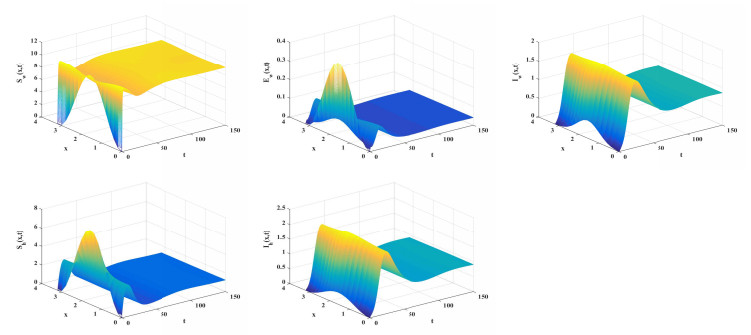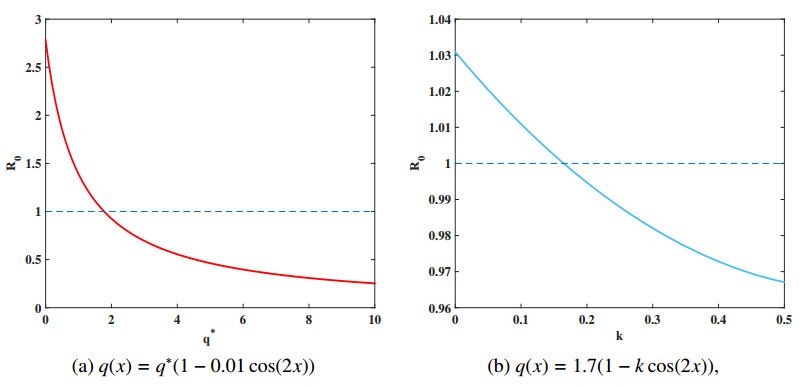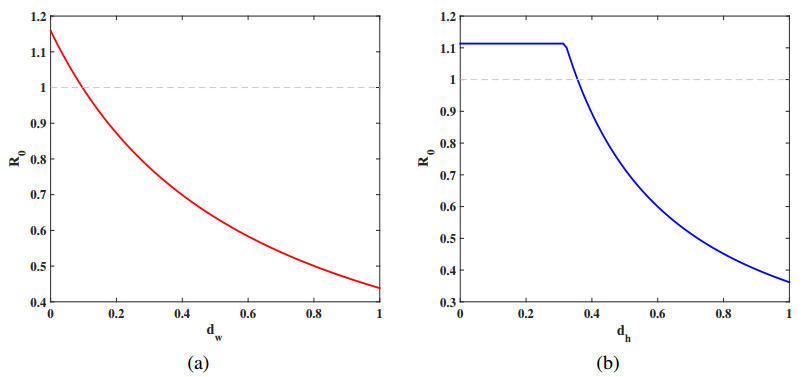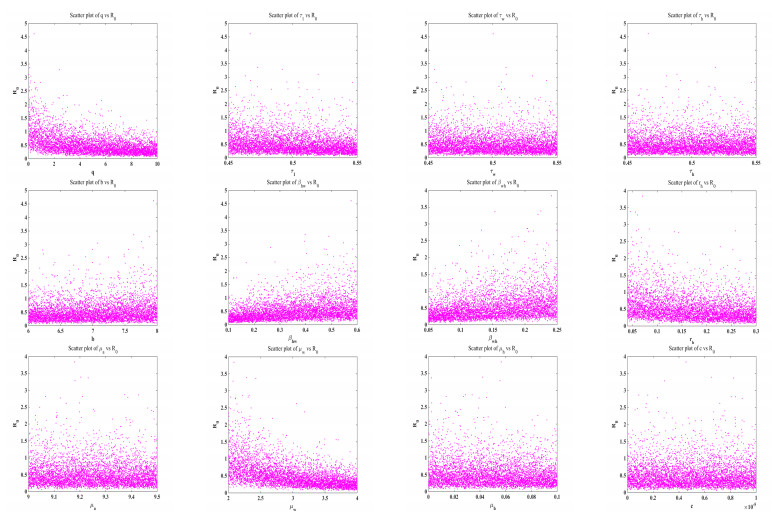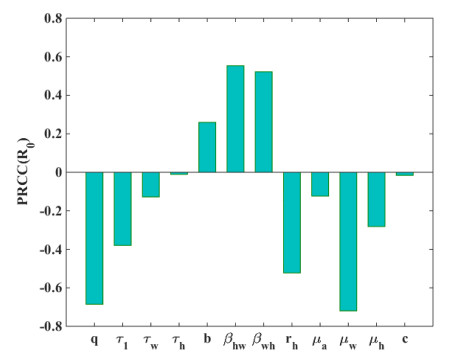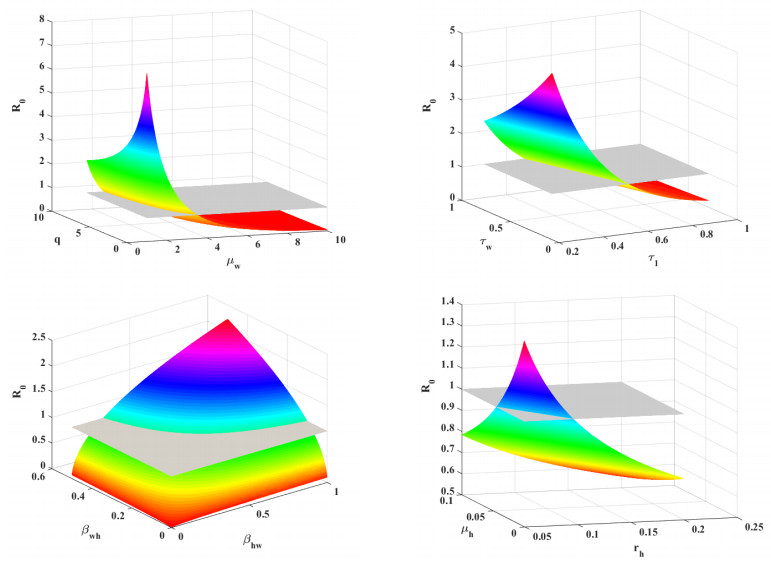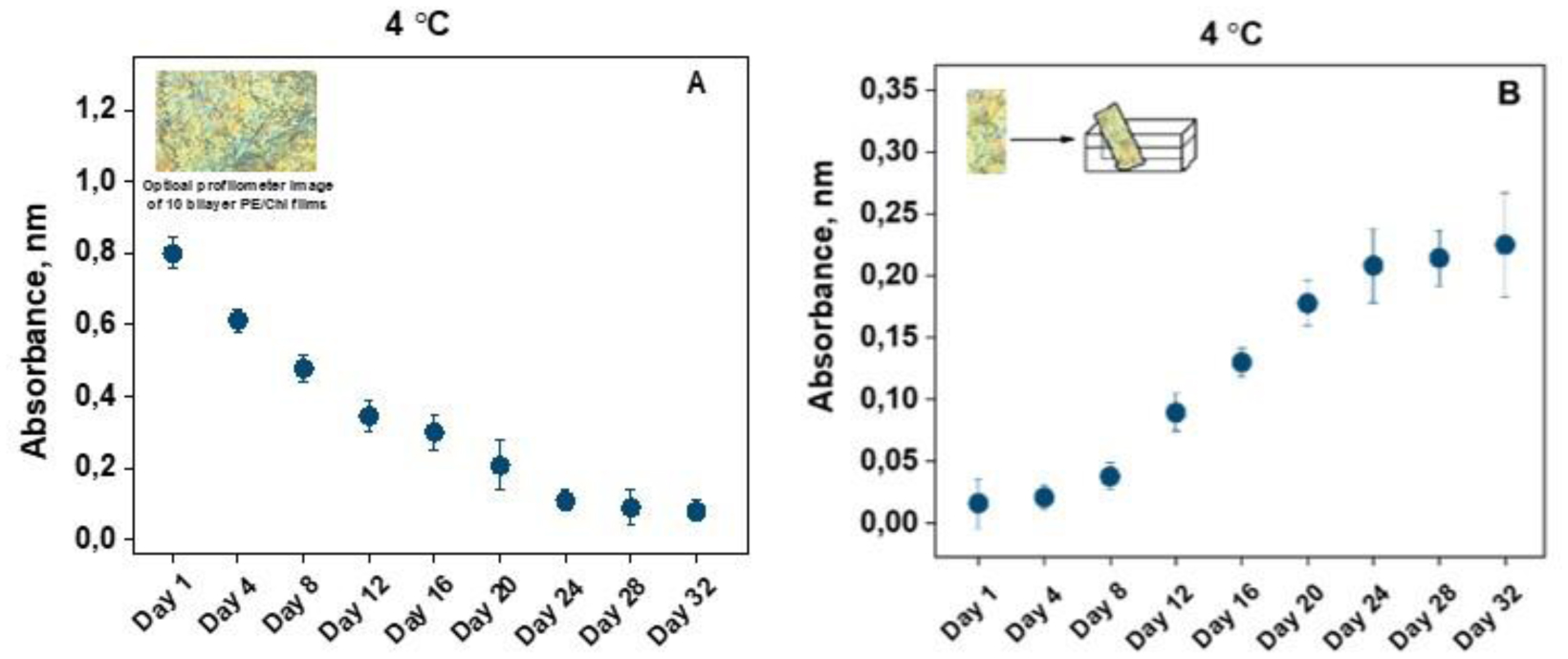1.
Introduction
Malaria remains a major global health challenge, primarily affecting tropical and subtropical regions. The disease is caused by Plasmodium parasites, transmitted through bites of infected Anopheles mosquitoes. Symptoms include fever, chills, and flu-like illness, and without treatment, malaria can lead to severe complications and death [1]. According to the World Health Organization (WHO), in 2023 there were an estimated 263 million malaria cases and 597,000 malaria deaths worldwide. The African region carries a disproportionately high share of the global malaria burden, accounting for 94% of malaria cases and 95% of malaria deaths [2]. Despite ongoing efforts to control malaria, it continues to be a major global health issue that is especially prevalent in the sub-Saharan African region [3].
Mathematical models are essential for depicting the dynamics of disease transmission and developing effective control strategies [4,5,6]. Early models often assumed a homogeneous environment, ignoring spatial variations such as population density, mosquito distribution, or local ecological conditions. However, newer studies have focused on the importance of spatial heterogeneity in malaria transmission and the need for reaction-diffusion models that incorporate these variations [7]. Spatial heterogeneity significantly impacts malaria transmission, especially in regions with diverse ecological factors. Moreover, delays, such as the incubation periods of malaria in humans and mosquitoes, are crucial components of modern models. These time lags affect the stability and transmission dynamics of malaria. By including these delays in reaction-diffusion malaria models, researchers can better simulate real-world scenarios and assess the effectiveness of control measures over time [8]. For articles on the variable malaria model, please refer to [9,10].
Recent studies have shown promising results with the use of Wolbachia in controlling mosquito-borne diseases, including malaria and dengue. Field trials conducted in various parts of the world have demonstrated that releasing Wolbachia-infected Aedes aegypti mosquitoes can significantly reduce dengue transmission [11]. Similarly, the potential of Wolbachia to control malaria transmission has been explored through laboratory and field studies involving Anopheles mosquitoes, the primary malaria vectors [12]. Moreover, studies in malaria-endemic areas, including regions in Indonesia and Australia, have demonstrated that Wolbachia-infected mosquitoes can successfully integrate into local mosquito populations. This indicates a viable and potentially large-scale strategy for managing malaria [13,14]. Consequently, it is of great importance to investigate the effects of Wolbachia-based methods that disrupt insect reproduction on malaria control efforts.
This paper aims to study the effect of releasing Wolbachia-infected male mosquitoes on malaria control. The paper proceeds with the following structure. The next section details the development of our mathematical model. The well-posedness of the model is studied in Section 3. Section 4 delves into the introduction of the basic reproduction number, denoted as R0. Section 5 focuses on analyzing the threshold dynamics of our model, which are contingent upon the value of R0. Section 6 presents numerical simulations to elucidate the theoretical results, explore the impact of the release ratio of Wolbachia-infected males on transmission and control of malaria, and perform a sensitivity analysis. The paper concludes with a summary in the final section.
2.
Model formulation
2.1. Age-structured model with mosquitoes
The mosquito population has two subclasses: the aquatic population and the winged population. Let L1(x,a1,t) represent wild mosquitoes at time t, position x, and chronological age a1.A(x,t) aquatic mosquitoes at time t and position x. W(x,t) represents female winged mosquitoes at time t and position x. Ω is a bounded region with a smooth boundary ∂Ω. In the aquatic stage, limited habitat space and food resources lead to intense intraspecific competition among the larvae. Consistent with the approach proposed in [15], we utilize the following classic age-structured equations and introduce an additional nonlinear factor to characterize the evolutionary dynamics of mosquito populations under such competition. For t≥0,a1>0
where ∇ indicates the gradient, n is the outward unit normal vector on ∂Ω, d(x,a1) denotes the diffusion coefficient, and g(L1) represents a continuous function of L. The expressions for d(x,a1) and g(L1) are as follows:
Here, dw signifies the diffusion coefficient for adult mosquitoes. Meanwhile, c indicates the intraspecific competition rate among the larvae, and μa and μw correspond to the natural mortality rates of larvae and adult mosquitoes, respectively. Then A(x,t) and W(x,t) can be determined by integrating the population density over the specified age ranges, as detailed below
2.2. Releasing Wolbachia-infected male mosquitoes
The female male proportion is assumed to be 1:1. Assuming that Wolbachia-infected male mosquitoes are deployed under a proportional release strategy, that is, the released amount of Wolbachia-infected male mosquitoes is proportional to the current wild male mosquitoes. Here, q(x) represents the ratio of released Wolbachia-infected males to wild males. Let Wc(x,t) be the Wolbachia-infected male mosquitoes. Then we have Wc(x,t)=q(x)W(x,t).
We assume that Wolbachia-infected male mosquitoes have the same mating ability as wild male mosquitoes. Thus, WcW+Wc=q(x)1+q(x) describes the probability of a wild female mosquito mating with Wolbachia-infected male mosquitoes. Then 1−q(x)1+q(x)=11+q(x) is the probability of a wild female mosquito mating with wild male mosquitoes. Denote ρ(x) as the egg-laying rate of each wild females mosquito. We have
From (2.1), we can get
It is natural to assume that L1(x,+∞,t)=0. By the characteristic line method, we can obtain the expression of L1(x,τ1,t). If we set w1(x,a1,s)=L1(x,a1,a1+s),a1∈(0,τ1], we have
We can obtain
If we let a1=τ1, then s=t−τ1, and we have
Thus, one has
2.2.1. Human mosquito model
Let Sw(x,t), Ew(x,t), and Iw(x,t) represent susceptible, exposed, and infectious (female) winged mosquitoes. Thus we have W(x,t)=Sw(x,t)+Ew(x,t)+Iw(x,t). Let Sh(x,t), Eh(x,t), Ih(x,t) and Rh(x,t) represent susceptible, exposed, infectious and recovered humans, respectively. The total density of human population can be expressed by Nh(x,t)=Sh(x,t)+Eh(x,t)+Ih(x,t)+Rh(x,t). Assume that Nh(x,t) satisfies the following equation:
where Λ and μh correspond to the influx rate and natural mortality rate of humans, respectively. According to Lemma 1 in [7], system (2.5) has a globally attractive positive steady state, denoted by N∗h(x). In this study, we assume Nh(x,t)≡N∗h(x) for ∀t≥0 and x∈Ω.
Let aw be infection age of winged mosquitoes and Lw(x,aw,t) be the density of infected winged mosquitoes. Then
So
From (2.6), we can get
It is natural to assume that Lw(x,+∞,t)=0. By the characteristic line method, we can obtain the expression of Lw(x,τw,t). Set w2(x,aw,s)=Lw(x,aw,aw+s),aw∈(0,τw]. We have
We can obtain
where Γw is the Green function of the operator ∇⋅(dw(⋅)∇)−μw(⋅) associated with the Neumann boundary condition, b(x) represents bite rate of mosquitoes, βhw(x) represents the transmission probability from infectious humans to adult mosquitoes.
Let aw=τw, then s=t−τw, and
We then have
Let ah be the infection age of humans. Similar to the derivation of ∂Ew(x,t)∂t and ∂Iw(x,t)∂t, we can obtain the following expressions of ∂Eh(x,t)∂t and ∂Ih(x,t)∂t:
where Γh is the Green function of the operator ∇⋅(dh(⋅)∇)−μh(⋅) associated with the Neumann boundary condition, dh represents the diffusion coefficient for humans, βwh represents the transmission probability from infectious mosquitoes to humans, and rh and μh represent recovery rate and death rate of infectious humans, respectively.
In a word, we can obtain the following nonlocal delays reaction-diffusion system:
We know that A(x,t),Eh(x,t), and Rh(x,t) are decoupled from the other equations. Then it can be applied to the following system:
where p(x)=12(1+q(x)),ι(x)=c(x)μa(x), βw(x)=b(x)βhw(x)N∗h(x),βh(x)=b(x)βwh(x)N∗h(x).
3.
The well-posedness
Let X=C(¯Ω,R5) be the Banach space with the supremum norm ‖⋅‖X, and X+=C(¯Ω,R5+). Let τ=max{τ1,τw,τh}. Define C=C([−τ,0],X) as the Banach space with the norm ‖φ‖=maxθ∈[−τ,0]‖φ(θ)‖X for φ∈C, and C+=C([−τ,0],X+). Then (X,X+) and (C,C+) are strongly ordered Banach spaces. For ς>0 and a function z:[−τ,ς)→X, we define zt∈C by zt(θ)=z(t+θ),θ∈[−τ,0]. Denote Tw(t),Ts(t), and Th(t) : C(¯Ω,R)→C(¯Ω,R) are the evolution operators associated with
Then, for ϑ∈C(¯Ω,R), one has
where Γs is the Green function of the operator ∇⋅(dh(⋅)∇)−μh(⋅) associated with the Neumann boundary condition. We can see that Tj(t) is strongly positive and compact, where j=w,s,h. Set T= diag{Tw(t),Tw(t),Tw(t),Ts(t),Th(t)}. Then T:X→X is a semigroup generated by the operator A= diag {A1,A1,A1,A2,A3} defined on D(A)=D(A1)×D(A1)×D(A1)×D(A2)×D(A3), in which
For φ=(φ1,φ2,φ3,φ4,φ5)∈C+, define F=(F1,F2,F3,F4,F5):C+→X as
Then system (2.11) can be rewritten as an abstract functional equation as follows:
where u:=(Sw,Ew,Iw,Sh,Ih).
According to Corollary 8.1.3 in [16] and Corollary 4 in [17], we can get the following lemma.
Lemma 3.1. System (2.11) with an initial value function φ∈C+ has a unique mild solution u(⋅,t,φ) on its maximal interval of existence [0,tφ). Moreover, u(⋅,t,φ)∈C+ for any t∈[0,tφ), and u(⋅,t,φ) is a classical solution of system (2.11) for t>τ.
Lemma 3.2. System (2.11) with an initial value function φ∈C+ has a unique global classical solution u(⋅,t,φ) with u0=φ for t∈[0,∞). Moreover, the solution semiflow Υ(t)=ut(⋅):C+→C+ has a compact global attractor in C+.
Proof. From the first and fourth equations of (2.11), we have
So, for any φ∈C+, Kw,Kh>0 and t0=t0(φ)>0 exist such that Sw(⋅,t,φ)≤Kw and Sh(⋅,t,φ)≤Kh for ∀t≥t0.
Assume M1(t)=∫ΩSw(x,t)dx,M2(t)=∫ΩEw(x,t)dx,M3(t)=∫ΩIw(x,t)dx,M4(t)=∫ΩSh(x,t)dx,M5(t)=∫ΩIh(x,t)dx. Integrating Sw(x,t) in system (2.11), we can obtain
where K1=e−μa_τ1ι_(1−e−μa_τ1). Thus
Integrating Ew(x,t) in system (2.11), we can obtain
We can then get
It implies that
So, M2(t) is uniformly bounded.
Since Γw(⋅,⋅,⋅) is bounded, by integrating Iw(x,t) in system (2.11), we can obtain
for some positive constant K2. One then has
where μ1_=min{μw_,μa_}. It imply that there are a φ−dependent positive constant K3 and a φ−independent positive constant K4 such that
So, M3(t) is uniformly bounded.
Similarly, we can obtain
Thus
Since Γh(⋅,⋅,⋅) is bounded, by integrating Ih(x,t) in system (2.11), we can obtain
for some positive constant K5. One then has
It imply that there are a φ−dependent positive constant K6 and a φ−independent positive constant K7
So, M5(t) is uniformly bounded. By the comparison theorem for delayed parabolic equations [16], we find that there exist φ−independent positive number K8,K9,K10 and t1=t1(φ)>t0(φ)+τ such that Ew(⋅,t,φ)≤K8, Iw(⋅,t,φ)≤K9 and Ih(⋅,t,φ)≤K10 for any t≥t1. So, the solution of system (2.11) is global and the solution semiflow Υ(t)=ut(⋅):C+→C+ is point dissipative by Theorem 2.1.8 in [16]. Based on Theorem 3.4.8 in [18], Υ(t) has a compact global attractor in C+ for t≥0. □
4.
The basic reproduction number
Set Ew=Iw=Ih=0 in system (2.11). Then, Sw(x,t) satisfies the following system:
By Theorem 11 in [19] and Lemma 2.1 in [20], system (4.1) admits a globally attractive positive steady state W∗(x). It is easy to know that system (2.11) has an infection-free steady state E0(x)=(W∗(x),0,0,N∗h(x),0). Linearizing system (2.11) at E0(x), we can get
Consider the following linear nonlocal and cooperative reaction-diffusion system:
Substituting Iw(x,t)=eλtψ1(x) and Ih(x,t)=eλtψ2(x) into (4.2) and (4.3), we have
and
By similar methods to Theorem 7.6.1 in [21], we can see that (4.5) has a principal eigenvalue λ0(W∗) with strongly positive eigenfunctions. λ0(W∗) varies continuously under small perturbations W∗. Similar to Lemma 2.1 in [22], we can obtain the next lemma.
Lemma 4.1. The eigenvalue problem (4.4) admits principal eigenvalues associated with a strongly positive eigenfunction, denoted ˜λ0(W∗,τ). Moreover, ˜λ0(W∗,τ) and λ0(W∗) have the same sign.
Assume ϕ(x):=(ϕw(x),ϕh(x)). Assume that ϕ(x) is the spatial distribution of the initial infective female winged mosquitos and humans. It is easy to see that the distribution of those infective individuals at time t>0 is described by T(t)ϕ(x):=(Tw(t)ϕw(x),Th(t)ϕh(x)). Then the distribution of new infectious female winged mosquitos can be expressed as
Therefore, the total distribution of infectious female winged mosquitos during the infective period is
Similarly, the total distribution of infectious humans during the infective period is
Define the operator F on C(¯Ω,R)×C(¯Ω,R) as
where
and
Then, we can define the next reproduction operator as
So, Based on the result in [23], the basic reproduction number R0 can be defined by
Additionally, we can get the following lemma.
Lemma 4.2. R0−1 has the same sign as λ0(W∗).
5.
Dynamic analysis
Theorem 5.1. If R0<1, then the infection-free steady state E0(x) of system (2.11) is globally attractive in C+.
Proof. When R0<1, according to Lemmas 4.1 and 4.2, we have ˜λ0(W∗,τ)<0, Since limζ→0˜λ0(W∗+ζ,τ)=˜λ0(W∗,τ), a small enough ζ0>0 exists such that ˜λ0(W∗+ζ0,τ)<0.
Recall that W∗(⋅) is globally attractive for system (4.1), we have lim supt→∞Sw(⋅,t)≤W∗(⋅). So, for some positive constant t0, we have Sw(⋅,t)≤W∗(⋅)+ζ0 for t≥t0. Then, for all t≥t0, we can get
Set ˜ψ be the strongly positive eigenfunction corresponding to ˜λ0(W∗+ζ0,τ). Then, for t>0, the following linear system
admits a solution ˜u(x,t)=e˜λ0(W∗+ζ0,τ)t˜ψ(x). Then, for any given φ∈C+, there is some positive constant ˜m, and one has (Iw(⋅,t,φ),Ih(⋅,t,φ))≤˜m˜u(⋅,t) for all t∈[t0−τ,t0]. According to the comparison principle, we can obtain
Therefore, limt→∞(Iw(x,t,φ),Ih(x,t,φ))=(0,0) uniformly for x∈¯Ω. Then Sw(x,t),Ew(x,t),Sh(x,t) in system (2.11) are asymptotic to the following equations
Therefore, limt→∞Ew(x,t,φ)=0, limt→∞Sw(x,t,φ)=W∗(x), limt→∞Sh(x,t,φ)=N∗h(x) uniformly for x∈¯Ω. This completes the proof. □
Lemma 5.1. For the solution (Sw(x,t,φ),Ew(x,t,φ),Iw(x,t,φ),Sh(x,t,φ),Ih(x,t,φ)) of system (2.11) with an initial value function φ∈C+.
(i) For any t>0, x∈ˉΩ, one has Sw(x,t,φ)>0 and Sh(x,t,φ)>0. Furthermore, for ∀φ∈C+, there is φ−independent positive constant ζ such that
(ii) Assume that there exists some t∗≥0 such that Iw(⋅,t∗,φ)≢0 and Ih(⋅,t∗,φ)≢0, then the solution satisfies
Proof. (i) From Lemma 4.1, for any t>0, x∈ˉΩ and an initial value function φ∈C+, there is an ˘N1>0 such that Sh(x,t,φ)≤˘N1 and Ih(x,t,φ)≤˘N1. Let vw(⋅,t,φ) satisfy
It follows from the comparison principle that
for any t>0 and φ∈C+. By Lemma 2.1 in [20], system (5.4) admits a globally attractive positive steady state v∗w(x). Set ζw=minx∈ˉΩv∗w(x), then we have
Similarly, from Lemma 4.1, for any t>0, x∈ˉΩ, φ∈C+, there is an ˘N2>0 such that Iw(x,t,φ)≤˘N2.
It follows from the comparison principle that Sh(⋅,t,φ)>0, and there is an ζ<ζw such that lim inft→∞Sh(x,t,φ)≥ζ uniformly for x∈ˉΩ. This implies that (i) holds.
(ii) From system (2.11), we can obtain Iw and Ih, which satisfy
According to the maximum principle, assume some t∗≥0 exists such that Iw(⋅,t∗,φ)≢0 and Ih(⋅,t∗,φ)≢0, and then we have
This implies that (ii) holds. □
Theorem 5.2. The disease is uniformly persistent when R0>1; that is, ϱ>0 exists such that for any initial value function φ∈C+ with φ3(⋅,0)≢0 and φ5(⋅,0)≢0, we have
uniformly for x∈ˉΩ.
Proof. Let (Sw(x,t,φ),Ew(x,t,φ),Iw(x,t,φ),Sh(x,t,φ),Ih(x,t,φ)) be the solution of system (2.11) with an initial value function φ∈C+. Set
From Lemma 5.1, if φ∈∂S0, then Iw(x,t,φ)>0 and Ih(x,t,φ)>0 for x∈ˉΩ, t>0. So, we have Υ(t)S0⊂S0. Denote S∂={φ∈∂S0:Υ(t)φ∈∂S0,t≥0}.ω(φ) as the omega limit set of the forward orbit γ+(φ):={Υ(t)φ:t≥0}. We divide the proof into the following two claims.
Claim 1. For any φ∈S∂, the omega limit set ω(φ)=E0(x).
For any φ∈S∂, we have Υ(t)φ∈∂S0. Hence, either Iw(⋅,t,φ)≡0 or Ih(⋅,t,φ)≡0 for all t≥0. If Iw(⋅,t,φ)≡0 for all t≥0, then, from the third equation of (2.11), we have Ih(⋅,t,φ)≡0 for all t≥0. Then Ew(⋅,t,φ) satisfies
Thus, limt→∞Ew(x,t,φ)=0, uniformly for x∈ˉΩ. Then, Sw(⋅,t,φ) is asymptotic to the linear system (4.1). So, limt→∞Sw(x,t,φ)=W∗(x) uniformly for x∈ˉΩ. It is easy to know that Sh(⋅,t,φ) satisfies system (2.5). Then, limt→∞Sh(x,t,φ)=N∗h(x) uniformly for x∈ˉΩ. In words,
Assume Iw(⋅,t3,φ)≢0 for some t3>0. Then Ih(⋅,t,φ)≡0 for t>t3. From Lemma 5.1, we can obtain Iw(⋅,t,φ)>0 for t>t3. Since Ih(⋅,t,φ)≡0 for t>t3, we have Iw(⋅,t,φ)≡0 for t>t3 from the fifth equation of (2.11). This contradicts our assumption. Therefore, ω(φ)=E0(x) for any φ∈S∂.
Claim 2. E0(x) is a uniform weak repeller for S0, i.e.,
Since R0>1, from Lemma 4.2, λ0(W∗)>0. For any given σ∈(0,min{W_∗,Nh_∗}], set λ0(W∗,σ) be the principal eigenvalue of the nonlocal elliptic eigenvalue problem as follows:
We can then obtain limσ→0+λ0(W∗,σ)=λ0(W∗). So, we can find some sufficiently small constant σ∗∈(0,min{W_∗,Nh_∗}] such that λ0(W∗,σ∗)>0.
If (5.8) is not true, then φ∗∈S0 exists such that lim supt→+∞‖Υ(t)φ−E0(⋅)‖<σ∗. Then some t4>0 exists such that ‖Υ(t)φ−E0(⋅)‖<σ∗ for any t≥t4. So, Sw(⋅,t,φ∗)>W∗(x)−σ∗, Sh(⋅,t,φ∗)>N∗h(x)−σ∗, 0<Ew(⋅,t,φ∗)<σ∗, 0<Iw(⋅,t,φ∗)<σ∗, and 0<Ih(⋅,t,φ∗)<σ∗ for any t≥t4. Then we have
for all t≥t5:=t4+τ.
Set ψ=(ψ1,ψ2) be the positive eigenfunction associated with the principal eigenvalue ˜λ0(W∗,τ,σ∗) of the following eigenvalue problem:
From Lemma 4.1, ˜λ0(W∗,τ,σ∗) and λ0(W∗,σ∗) have the same sign. So, ˜λ0(W∗,τ,σ∗)>0. Consider the following the linear system:
for t≥t5. It is easy to see that system (5.12) has a solution (ν1(x,t),ν2(x,t))=e˜λ0(W∗,τ,σ∗)t((ψ1(x),ψ2(x))). Together (5.10) with the comparison principle, we can see that a sufficiently small positive number L exists such that
Since ˜λ0(W∗,τ,σ∗)>0, we get
which is a contradiction. Therefore, (5.8) is true.
So, E0(⋅) is an isolated invariant set C+, and WS(E0(⋅))∩S0=∅, in which WS(E0(⋅)) is a stable set of E0(⋅). Define a continuous function f:C+→R+ with the following form:
Clearly, f−1(0,+∞)⊂S0. From Lemma 5.1 (ii), we can see that if f(φ)=0 for φ∈S0, or f(φ)>0, then f(Υ(t)(φ))>0 for any t>0. So, f is a generalized distance function for the semiflow Υ(t):C+→C+. By Theorem 3 in [24], we can see that ϱ0>0 exists such that minϑ∈ω(φ)f(ϑ)≥ϱ0 for any φ∈S0. This implies uniform persistence. □
6.
Numerical simulations
In this section, numerical simulations are conducted to validate the analytical outcomes. By [25], we choose H∗(x)=53(km2)−1, the periodicity is set to T=12 months, and Ω=(0,π). The parameter values are as follows: N∗h=50,μh=0.00157, Λ=N∗h×μh, rh=0.08,c=0.000001,ρ=50,μa=9,μw=2,τ1=0.5605,τw=17.25/30.4,τh=15/30.4,dw=0.0125,dh=0.1,
6.1. Dynamic behavior of model (2.11)
We set the initial functions as follows:
Choose b=5. Numerical simulation determines that R0≈0.2844<1. Based on Theorem 5.1, E0(x) is globally attractive. As shown in Figure 1, the disease will eventually vanish. In other hand, we set b=18. The basic reproduction number can be calculated to be R0≈1.024>1. The dynamic behavior of model (2.11) is illustrated in Figure 2, corroborating the theoretical result of Theorem 5.2. This indicates that an outbreak of the disease is likely to occur.
6.2. The effect of the release ratio of Wolbachia-infected males on R0
Let q(x)=q∗(1−kcos(2x)), and set b=18,βhw(x)=0.6,βwh(x)=0.2. Firstly, fix k=0.01. We investigate the correlation between q∗ and R0. From Figure 3(a), as q∗ increases, R0 gradually decreases and crosses the threshold of 1. Next, fix q∗=1.7. We analyze the influence of spatial heterogeneity, represented by k, on R0. Figure 3(b) demonstrates that R0 is an increasing function with respect to k. It should be noted that q(x) represents a homogeneous distribution when k=0. Moreover, set q=1.5, we explore the effects of the diffusion rates dw and dh on R0 as shown in Figure 4.
6.3. Sensitivity analysis
In this part, we explore the situation where the parameters of model (2.11) are constant. By [26], the basic reproduction number R0 can be calculated as
Figure 5 displays scatter plots that illustrate the correlation between the parameters and the basic reproduction number R0. Figure 6 displays a bar chart illustrating the partial rank correlation coefficient (PRCC) values for different parameters in relation to R0. The bars represent the correlation coefficients for each parameter, with some bars above and some below the zero line, indicating positive and negative correlations, respectively. The parameters βhw and βwh show the strong positive correlations, while q, rh and μw show the most negative correlations. The parameter b shows a moderate positive correlation with R0. Additionally, some parameters τ1, τw, and μh show moderate negative correlations. The variations in the remaining parameters have a moderate impact on R0. The contour diagrams in Figure 7 illustrate the joint effect of two parameters on the basic reproduction number R0.
7.
Conclusions
This paper has presented a comprehensive mathematical model for the spatial spread of malaria, incorporating the effects of nonlocal delays and the release of Wolbachia-infected male mosquitoes as a control strategy. The model's dynamics were primarily governed by the basic reproduction number R0, which served as a threshold parameter. Through rigorous theoretical analysis, we established that when R0<1, the infection-free steady state is globally attractive, indicating that malaria can be effectively controlled under this condition. Conversely, when R0>1, the disease persists uniformly, suggesting that malaria will persist in the population. The simulations confirmed the theoretical predictions and provided insights into the impact of the release ratio of Wolbachia-infected males on the transmission and control of malaria. Future research could further explore the integration of Wolbachia release with other vector control methods to optimize malaria elimination efforts.
Use of AI tools declaration
The authors declare they have not used Artificial Intelligence (AI) tools in the creation of this article.
Acknowledgements
The work is partially supported by the National Natural Science Foundation of China (No. 12201007), the Natural Science Foundation of Shandong Province (ZR2024QA021), the Natural Science Research Project of Anhui Educational Committee (No. 2022AH050961, 2023AH030021), the Teaching Research Project of Anhui Polytechnic University (No. 2022jyxm67), the Science and Technology Plan Program of Wuhu Municipal (No. 2024kj016).
Conflict of interest
The authors declare that there are no conflicts of interest.
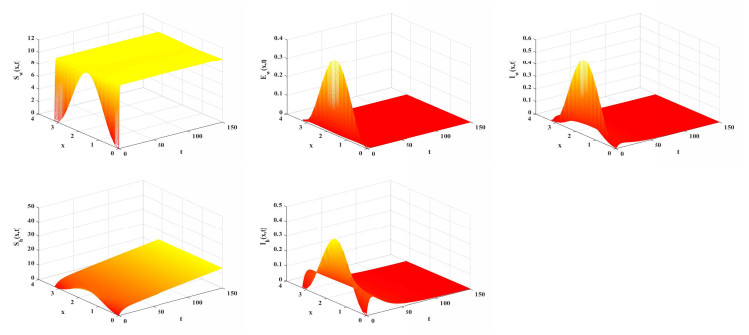









 DownLoad:
DownLoad:
